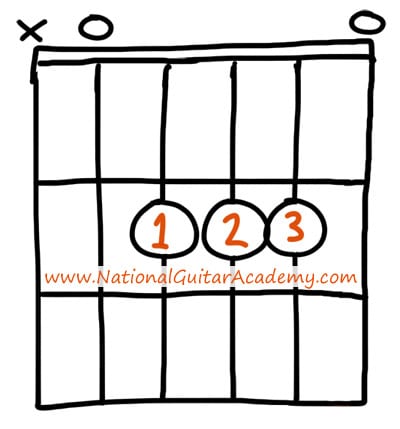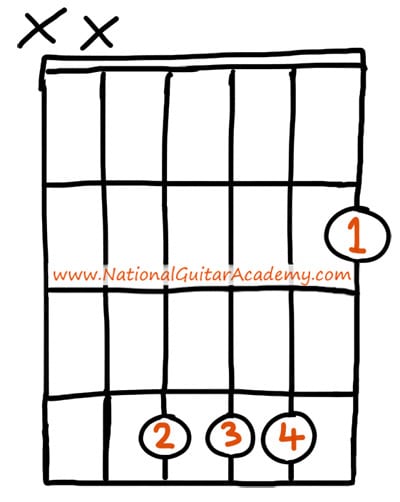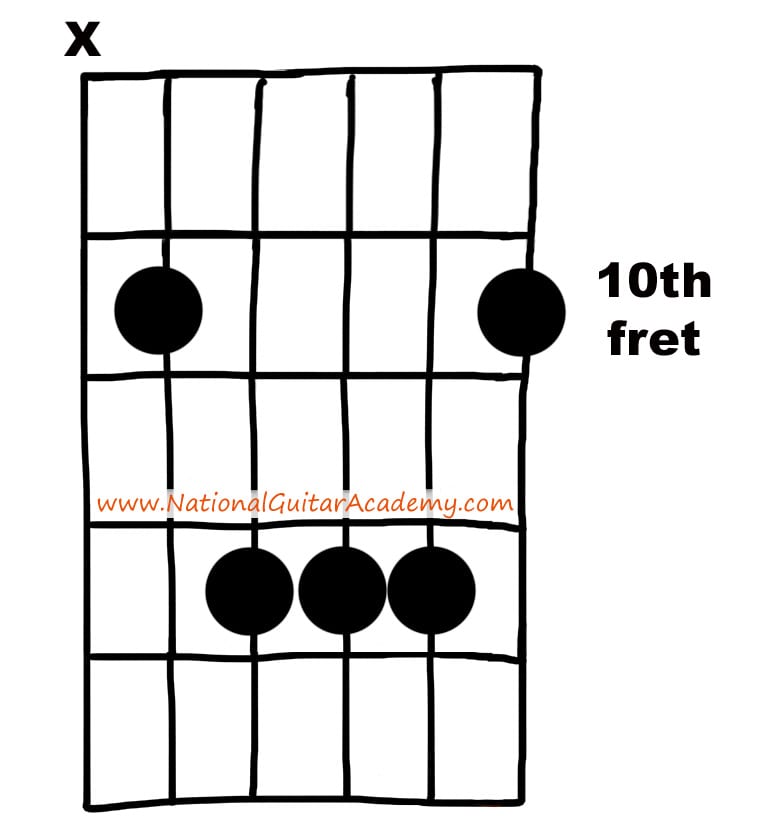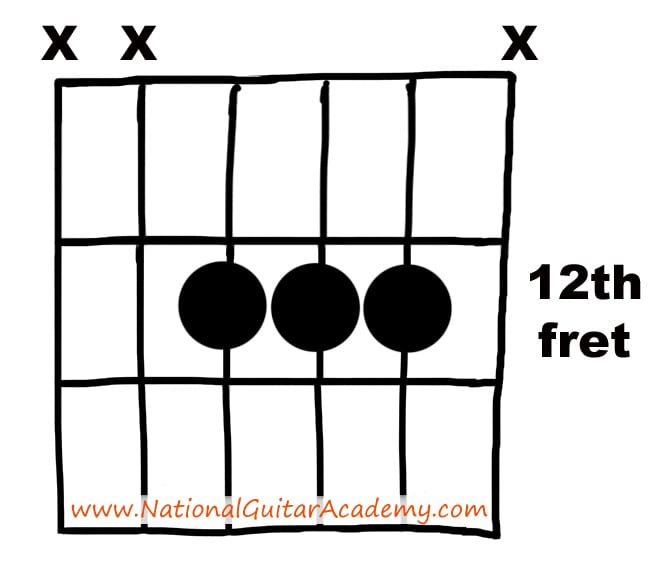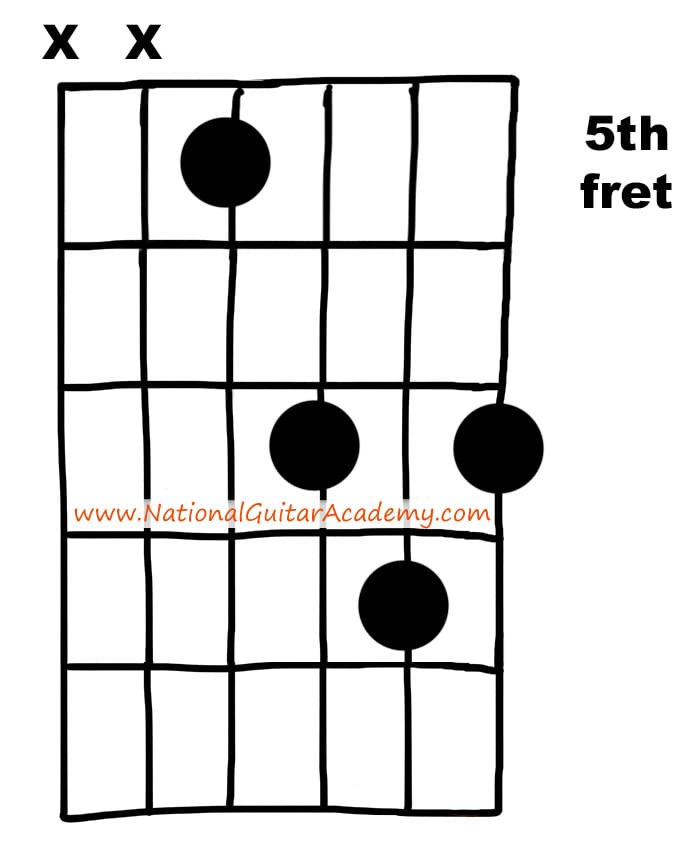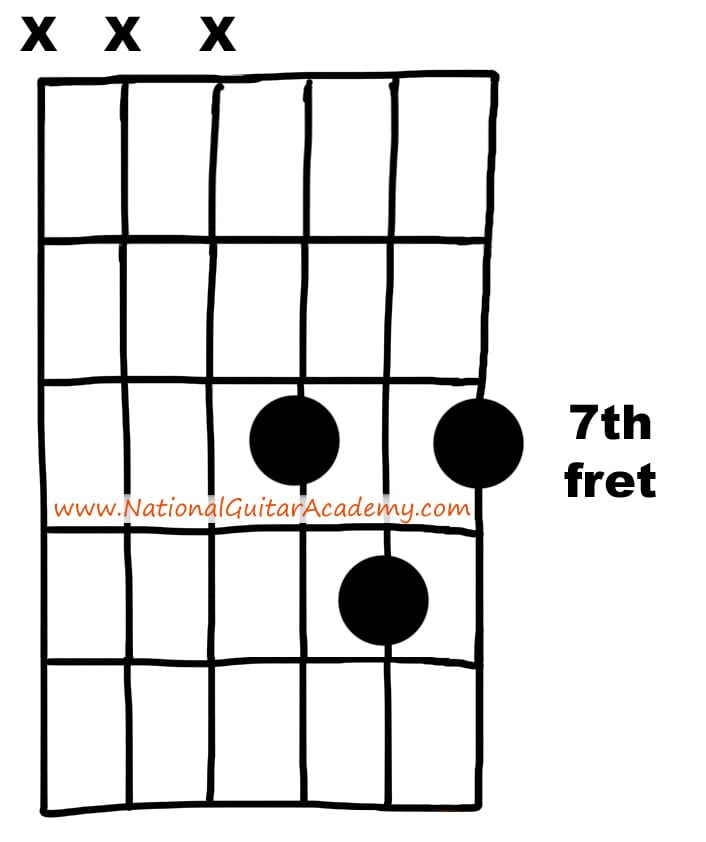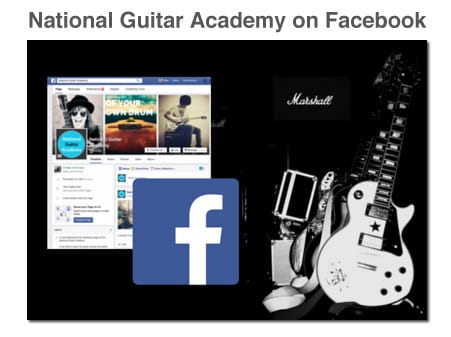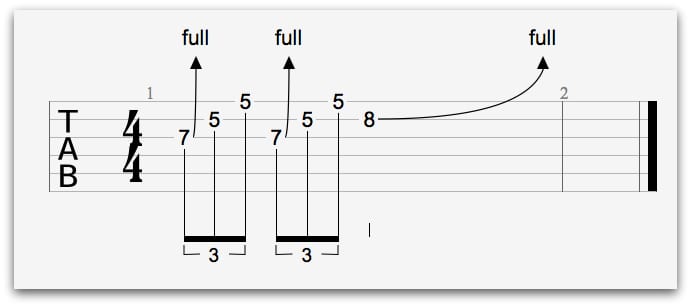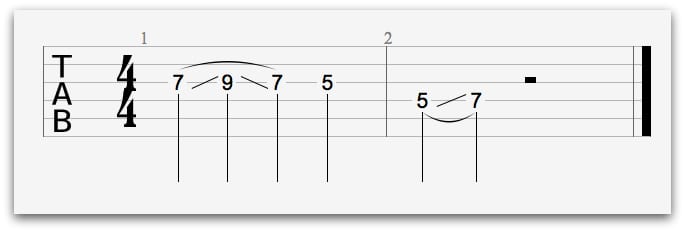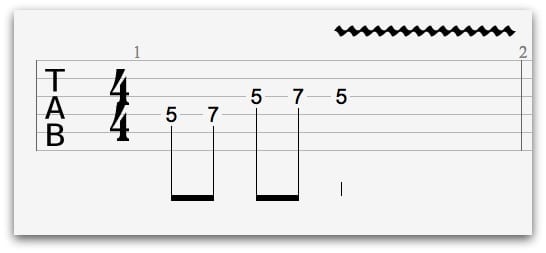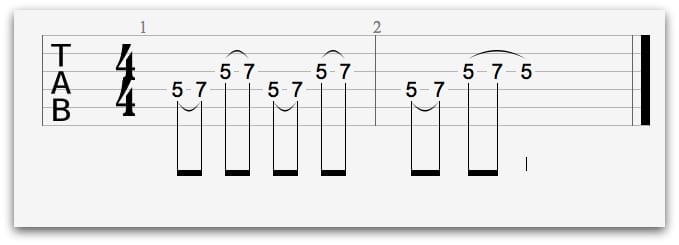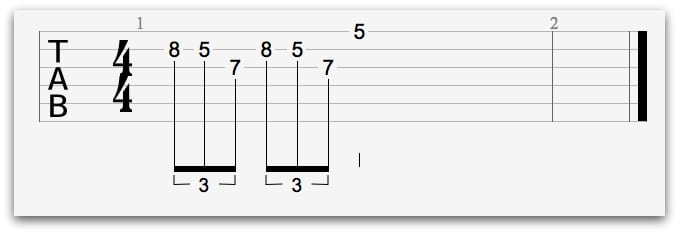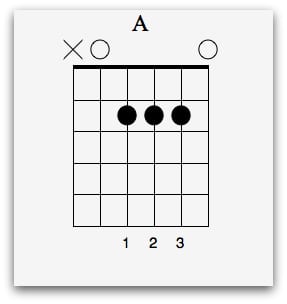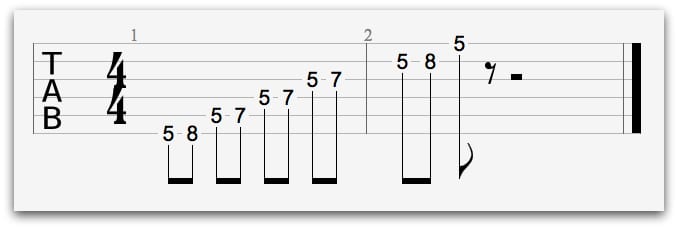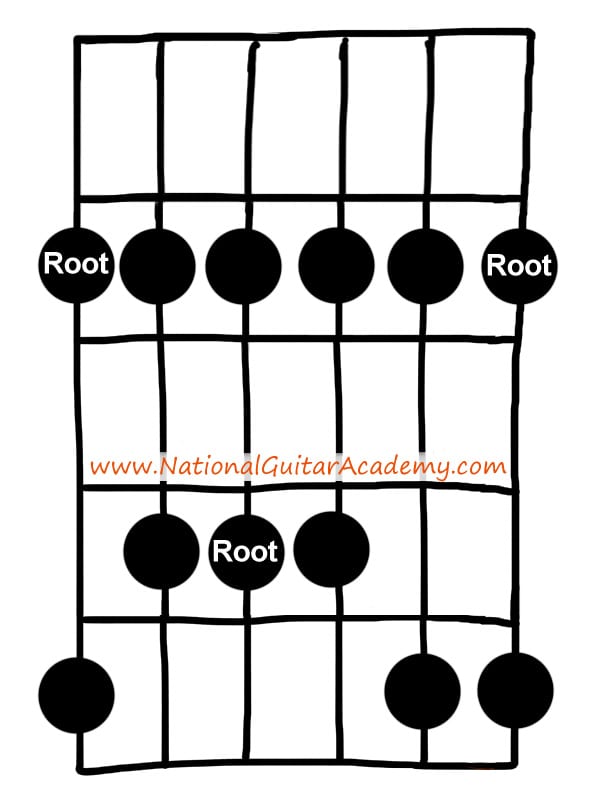.
.
Part 4 – How to use the CAGED system to sound amazing with alternate chord voicings
Learning how to play lead guitar is, at heart, very simple. Play stuff that sounds good with the other stuff.
So far we’ve looked at keys and scales. These things are note-based. But now we’re going to look at something chord-based.
For most people who want to learn how to play lead guitar, this is much more straightforward than understanding keys and scales. Let’s do it.
What is the CAGED system?
The CAGED system is one of those things that lots of guitar learners hear about, but in my experience, they rarely understand it.
If you want to learn how to play lead guitar, you need to ‘get’ this!
Like all of this technical stuff, it sounds very confusing, but it’s actually pretty simple.
A simple way to understand the CAGED system
A chord is a shape. (A shape we make with our fingers.)
We learn open chords first. We press these shapes down and strum.
Some of these shapes are ‘fixed’ in place. We can only play them as open chords on the first 1-3 frets.
But not all chords are ‘fixed’.
In fact, many chords are what we call ‘moveable shapes’. They can be moved up and down the fretboard to play other chords.
We just slide the chord from it’s starting position to another place and play it. Hey presto, we hear a new chord, even though we’re still holding the shape of the original chord.
Our hand may be making the same chord shape, but because we’re applying the shape in a different part of the neck what we HEAR is a different chord.
Using how these shapes move is a powerful part of learning how to play lead guitar. Let’s look at some examples:
Examples of the CAGED system in practice
If we take an ‘A’ chord….
…and move it up the neck 2 frets it becomes a B chord…
We sometimes move these shapes around by putting a ‘barre’ behind them. These chords are then called ‘barre chords’.
But we can play plenty of moveable shapes without the barre if we choose too. In fact it’s sometimes easier.
There are five main moveable shapes. To learn how to play lead guitar you need to at least be aware of all 5.
The five moveable shapes are based on the following chords: C, A, G, E and D.
And for that reason, we refer to this as the ‘CAGED system’.
It’s not really a ‘system’ at all, it’s just an acronym we use to remember these 5 shapes.
So you know now that you can slide C, A, G, E and D chords up the fretboard to make other chords.
In your mind, you will always perceive them as C, A, G, E and D chords because that’s how you first learnt them. But as you move them around the fretboard they become other chords.
Earlier, we distilled the essence of how to play lead guitar by saying ‘play stuff that sounds good over the other stuff‘.
Well one of the things you can do that will ALWAYS sound good over the other stuff is to play along with the chords of the song.
But of course, if you literally just strum along and replicate exactly what the other musicians/instruments are playing, that will be pretty boring. It won’t add much to the track at all.
But if you play the same chords, but with a different voicing, that will sound awesome.
This is a critical point for learning how to play lead guitar, so stay with me here!
If you want to play a G chord, you could play it in 5 different positions using C, A, G, E and D chord shapes.
- If you play a barred C shape starting on the 7th fret, that chord is G.
- If you play a barred A shape starting on the 10th fret that chord is G.
- If you play an open G shape, that chord is obviously G!
- If you play a barred E shape, starting on the 3rd fret, that chord is G.
- If you were to play a D shape on the 7th fret that chord is G.
Can you see our CAGED system in the above examples?
Let’s make this easy!
Now of course, some of these shapes are very fiddly to play, so most of the time we don’t play them!
But we DO play the shapes that are easier to play. And these can be a lead guitarists best friend.
If you want to learn how to play lead guitar you must get comfortable with the E, A and D shapes from ‘CAGED’.
By a long distance, the E shapes, A shapes and D shapes are the ones that get used most often.
When we play the A and D shapes, we can just play the triads and abandon the barre. This sounds fantastic!
How to use triads to sound amazing
Learning how to play lead guitar means having plenty of tricks in your toolkit. Triads are a brilliant tool. Let’s look at an example:
So instead of playing our G like this (as a barred A shape)….
…we can play like this, as a pure triad:
Can you see that this is the same as the above chord, but we just omitted the notes from the 10th fret?
Now this is EASY to play. We can play it with one finger!
This type of TRIAD shape is the distilled essence of the chord. It is the sound in its purest form.
It can sound a little lost when played by itself, but when used in a complementary setting as lead guitar over a rhythm guitar, it sounds fantastic.
How could you use this?
If you want to play over a G chord, but you don’t want to simply strum a G, then you could play this triad.
Or you could pluck the notes out, arpeggio style. This will complement what’s already being played. With some effects added, triads can sound devastating. Try it!
Let’s look at the D triad
It would be pretty hard to play G like this (as a barred D)…
…we can play it like this as a triad and make things easier…
Again, this sounds fantastic as a secondary guitar piece. It’s very high-end and that treble can cut through and really balance out a chunky and full sounding rhythm guitar.
If one person plays a bass-heavy power chord and another play a high-end D triad, you create a very full and well-balanced overall sound.
Listen to something like ‘The Bucket” by Kings of Leon to hear how cool simple triads can sound as lead guitar.
Can we used CAGED with minor chords too?
Yes. We simply use the minor chord shape and move that up the neck as we did for the major shapes.
A quick summary of the CAGED system
To learn how to play lead guitar, you must know and use the CAGED system. Let’s recap.
- We can play all chords in 5 different shapes.
- We do this by moving the open chord shapes of C, A, G, E and D up the neck, as moveable shapes.
- The easiest ones to use are E, A and D.
- Triads sound amazing.
Ok, let’s move on and look at some specific tricks you can use to learn how to play lead guitar, like riffs, string bending and vibrato.
.
.
Part 5 – The Tricks Of The Trade For Lead Guitarists
So far we’ve talked about lots of ‘conceptual’ stuff in this guide – and that’s important because understanding these concepts means you will understand the instrument!
But now let’s look at some specific practical techniques.
Here’s what you’ll find in this section:
- Improvisation tips and riff exercises
- Understanding string-bending (video)
- How to slide between notes (video)
- How to use vibrato to add polish to your lead guitar technique (video)
- Using hammer-ons and pull offs
- Why root notes rule (and how to use them)
- Active listening and some classic lead guitar ‘phrases’
- 3 practice riff exercises & practice backing track
How To Play Lead Guitar – Technique 1: String Bending
String-bending
This is where we bend the string up (or down) to make the pitch of the note go higher. If you want to learn how to play lead guitar this is an essential skill.
When we bend the strings it’s really important that it’s nice and relaxed. You don’t want to feel any tension/pain when doing this. It should feel absolutely comfortable.
Important points for string-bending
- Be relaxed, you don’t want to feel any tension or pain when doing this.
- Always aim for a note, our bends should always be in tune! (To help with this, we can pick a note higher up and bend up to it. By aiming for the note, it allows to improve our bending technique.) You’ll see an example of this in the video below.
- Make sure you have a smooth turning motion in your wrist when bending.
Check out this video from Jack:
How To Bend Guitar Strings Correctly
A couple of final points on string bending
Note that you can bend strings in quarter, half and full tones. You don’t have to bend all the way every time! (A common beginner mistake.)
Bending strings with one finger will make your fingers ache and your bends will lack control. Use 2 or 3 fingers when you bend strings. This will add strength and control to your bending.
You’ve got four fingers so experiment. A big part of learning how to play lead guitar is experimentation; this is how you develop a feel for the notes. In this instance the more fingers you use, the greater the bend. Develop that feel. Try it now! 🙂
A string-bending practice lick
Here’s an example of a lick which contains bends.
As a simple exercise, now try adding bending to your solos and here how it sounds.
How To Play Lead Guitar – Technique 2: Sliding
This can often add a slippery sound to our solos, which can be really cool and add an element of fluidity that juices things nicely.
- When sliding always make sure it’s nice and smooth going to the target note, we don’t want to over slide. Target your note and nail it with confidence.
How To Slide Notes Correctly
Sliding between notes is a really cool technique. (Learning how to play lead guitar can seem complicated at times, but this is a cool, easy technique that sounds great immediately.)
Here’s an example of a common sliding lick that you can practice as you learn how to play lead guitar.
Now try to solo using some sliding!
How To Play Lead Guitar – Technique 3: Vibrato
Vibrato adds a little bit of movement to the note. By doing this it adds a little bit of character and polish. (This technique is used a lot by violin players.)
When using vibrato technique, we use a similar motion to bending but with an important difference: When bending we use our wrist to bend up and we tend to move it at a larger angle. But with vibrato we use the same technique, but with a much smaller movement.
We usually use vibrato at the end or start of our phrases.
An important point about vibrato
You must keep pressing down with your finger for the vibrato to continue ringing. (You ‘shake’ the string, but you have to keep pressing down too!)
Vibrato is a great way to finish phrases. It’s subtle, but it adds a classy touch and makes everything sound more polished. This level of refinement and attention to detail is important when learning how to play lead guitar. Little things matter!
Watch this video of ours to see vibrato in action:
An example vibrato lead guitar lick
Can you hear the vibrato at the end? Try playing it without the vibrato and listen to how much more abruptly it ends.
Now try to solo over a backing track using vibrato technique.
How To Play Lead Guitar – Technique 4: Hammer-ons and Pull-offs
If you want to learn how to play lead guitar you must learn how to do hammer-ons and pull-offs. These are essential techniques.
The key point here is that we pluck the note only once, at the start. When our finger hammers-on we hear the second pitch. So we pluck once, but hear two pitches. The second note uses the force of the first pluck.
A pull-off is a hammer-on in reverse. And again, we only pluck once.
Hammer-ons and pull-offs video
To see these cool lead guitar techniques in motion, watch this video:
To learn how to play lead guitar we must practice this technique.
A cool lick to practice hammer-ons and pull-offs
Now try and use some hammer-ons in your solos.
Bonus Challenge! Can you solo with all 4 techniques?
Try a practice solo and use all four techniques. The most important thing here, as ever, is to have fun and enjoy it.
Techniques like these are the icing on top of the cake when we learn how to play lead guitar. In isolation, none of them seem hugely important but when they’re combined they make a huge difference.
How To Improve Your Improv
A huge part of learning how to play lead guitar is learning to improvise.
The best way to learn how to improvise is to try and make something musical. It might not be perfect the first time (or the 101st time), but we learn by making mistakes. (So make lots!)
Using ‘active listening’ to pick up extra tips
An important aspect of learning how to play lead guitar is listening to your favourite genres. Actively listen. Try and notice what gives a piece of music it’s character.
It’s hard to do, but sharpening your ears like this is a key part of learning how to play lead guitar.
For example if you want to learn how to play blues music, you should listen to that genre and try and pick out its idiosyncrasies. By doing this you are learning how the genre sounds and FEELS. I call this ‘active listening’. It takes practice, but it rewards you richly.
Classic lead guitar phrases
Getting some classic lead guitar phrases under your belt can give you some good tricks to fall back on. This is a very practical way to learn how to play lead guitar.
When we want to play a certain genre or style, it’s a good idea to have a couple of suitable phrases or licks under our belt beforehand.
If we learn a few musical phrases which are in that genre, we immediately begin to sound like that genre.
Here a few licks I’ve prepared which use the trusty A Minor Pentatonic scale. I decided to make them bluesy, as blues is great for soloing.
Riff example 1
Try this out. Can you repeat it after me?
Here’s another:
Riff example 2
What did you think of that one? A little harder?
Riff example 3
What do I do with these riffs?
Remember, a key part of learning how to play lead guitar is learning how to improvise.
Try playing these licks over a backing track in A minor. There’s loads of them on YouTube. Try this one:
I also like to use the smartphone app “Jam Tracks”. You tell it what key you want to jam in and it will play an appropriate backing track.
This is a brilliant way to improve your improvisational skills and solo ability. You tell the app the key and then you can wail all over it in an appropriate key.
A powerful tip

Practice with different genres and jam with other musicians as much as possible.
This is by fay the quickest way to grow as a musician.
.
The Importance Of Targeting Root Notes in our lead guitar work
The last thing we’re going to look at is targeting root notes. This is another crucial part of learning how to play lead guitar, so pay attention! 🙂
What are root notes?
Root notes are the very first note in a chord or scale. It’s the most important note.
So for example, an A major chord has the notes A, C#, and E in it. But the most important note, at the ‘tonal centre’ is A.
The root note of an A chord is ‘A’.
The A string is the first note we play in the chord. It’s the chord’s root note.
There is also an A note on the 2nd fret of the A string and this is also a root note. (Sometimes we have two root notes in a chord. They are the same note, one is simply an an octave higher than the other.)
To understand how to play lead guitar we must use this to our advantage.
The root note is always the name of the chord.
- The root note of a C chord is ‘C’.
- The root note of C minor is ‘C’.
- The root note of C minor 7 is ‘C’.
- The root note of “C minor 7 diminished 5th added 9” is ‘C’.
Why does that matter to a lead guitarist?
Because it applies not just to chords, but to keys and scales too.
If you play the A Minor Pentatonic scale, the root note will be ‘A’. This means you should finish your licks and phrases on an ‘A’ note. If you don’t do this, things will sound ‘unfinished’.
Learning how to play lead guitar means you must understand how to finish your licks or riffs. The root note will always sound great at the end.
The A Minor Pentatonic Scale has these notes in it:
A C D E G
The very first note of the scale is A. (This is the 5th fret on the E String.)
This means that the root note in an A Minor Pentatonic scale is A.
It’s the most important note in the scale. It will always sound good! Use it a lot. Finish your phrases on this note.
Is there only one root note in a scale?
Yes and no. The root note, in this example, will always be ‘A’. But there can be multiple ‘A’ notes in there. They are all root notes, but they sound different to one another because they’re octaves apart.
(They’re higher and lower than one another.)
In our above example you will spot the other root notes on the 7th fret of the D string and on the 5th fret of the high E string.
This will make it clearer:
These are your hero notes, use them lots!
How to play lead guitar: Tension and resolve
When we solo we want to try and target root notes to finish our phrases and licks.
Why? Because they bring a sense of ‘resolution’.
Great lead guitar work has both tension and resolve. If you want to learn how to play lead guitar you must be aware of this.
Light and dark. Rise and fall. We need both otherwise things become one-dimensional.
By targeting the root note, it allows us to hear that the phrase has finished. This is good for the listener. It feels ‘right’.
Root note finder exercise
Here are a few simple exercises you can do to help you with this.
- Pick a scale.
- Find all the root notes in the scale.
- Play a lick which starts on a root note.
- Play a lick which ends on a root note.
- Play a lick which starts and ends on a root note.
By targeting these notes, it allows our licks to sound strong and defined. If you want to learn how to play lead guitar you simply must know this.
Sometimes, you will deliberately not do this. This ‘plays’ with your audience. They are anticipating the resolution of the root note. If you don’t give it to them this drives tension.
Good lead guitarists use tension and resolve to their advantage. Develop this technique as you learn how to play lead guitar.
Download our lead guitar cheat-sheet to make things easier
It's hard to understand which scales work with which keys.
So we created a cheat-sheet! A key and scale-finder that you can use again and again.

Get your personalised guitar-learning plan 🎸
Get a custom guitar-learning plan here: Click here for GuitarMetrics™
World-Class Guitar Courses 🌎
Learn from the world's best guitar educators: Click here for our guitar courses
What Type of Guitarist Are You?
Take our 60-second quiz & get your results: Take The Quiz
Join the world's best online guitar school 🌎
- Get your own personalised guitar learning plan (customised just for YOU).
- World-class online guitar courses. Learn at your own pace.
- Community Campus & Learning Forum - A friendly community! Connect with our team & students. 😊
- Beginner Song library with chordsheets, tabs and tips. (Songs suitable for all levels!)
- Regular live streams, seminars and Q&A sessions - Learn from world-class guitar educators. Get all your questions answered!
Click here to learn more about National Guitar Academy membership 
Cool Guitar T-shirts 😎
Look cooler! Check out our merch: Click here to see our merch store
Want free guitar tips and video lessons delivered to your inbox?
Join over 100,000 guitar-learners and subscribe to our guitar-tips-by-email service. (It's free.)
We'll send you a series of lessons that will move you to the next level of your guitar journey.
Learn how everything fits together quickly, easily and effectively. We share ninja tips (for instant fun!) but also timeless fundamentals that will deepen your understanding.

Popular Lessons
How To Learn Guitar: An 11-Step Programme For Beginners
How To Choose The Perfect Beginner Guitar
More Cool Guitar Stuff
Learn about National Guitar Academy: About Us
Join us on Facebook for daily guitar tips.
Listen to our Learn Guitar Podcast for rapid guitar progress.
Check out our free chord lessons.
PS – One Last Bonus Tip
This Rolling Stone article is a great place to find inspiration and ideas (and an epic list of incredible guitar songs) that will help you in your journey to learn how to play lead guitar.
Where should we send it?
Get our best guitar tips & videos

